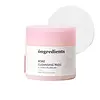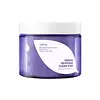What's inside
What's inside
 Key Ingredients
Key Ingredients

 Benefits
Benefits

 Ingredients Side-by-side
Ingredients Side-by-side

Water
Skin ConditioningVitex Agnus-Castus Fruit Extract
Skin ConditioningDipropylene Glycol
Humectant1,2-Hexanediol
Skin ConditioningPolyglyceryl-10 Caprylate/Caprate
EmulsifyingGlycerin
HumectantPolyglyceryl-4 Caprate
EmulsifyingThiamine Hcl
MaskingRiboflavin
Cosmetic ColorantNiacinamide
SmoothingCarnitine Hcl
HumectantPanthenol
Skin ConditioningBiotin
AntiseborrhoeicFolic Acid
Skin ConditioningAscorbic Acid
AntioxidantTocopherol
AntioxidantGinkgo Biloba Leaf Extract
Skin ConditioningDioscorea Villosa Root Extract
Skin ConditioningOenothera Biennis Flower Extract
AstringentArctium Lappa Root Extract
Skin ConditioningSodium Cocoyl Alaninate
Citric Acid
BufferingGluconolactone
Skin ConditioningSodium Citrate
BufferingEthylhexylglycerin
Skin ConditioningGlyceryl Caprylate
EmollientWater, Vitex Agnus-Castus Fruit Extract, Dipropylene Glycol, 1,2-Hexanediol, Polyglyceryl-10 Caprylate/Caprate, Glycerin, Polyglyceryl-4 Caprate, Thiamine Hcl, Riboflavin, Niacinamide, Carnitine Hcl, Panthenol, Biotin, Folic Acid, Ascorbic Acid, Tocopherol, Ginkgo Biloba Leaf Extract, Dioscorea Villosa Root Extract, Oenothera Biennis Flower Extract, Arctium Lappa Root Extract, Sodium Cocoyl Alaninate, Citric Acid, Gluconolactone, Sodium Citrate, Ethylhexylglycerin, Glyceryl Caprylate
Allium Cepa Bulb Extract
Skin ConditioningButylene Glycol
HumectantGlycerin
HumectantWater
Skin Conditioning1,2-Hexanediol
Skin ConditioningNiacinamide
SmoothingHouttuynia Cordata Extract
Skin ConditioningSodium Heparin
Skin ConditioningPanthenol
Skin ConditioningAllantoin
Skin ConditioningTrehalose
HumectantSodium Hyaluronate
HumectantHydrolyzed Hyaluronic Acid
HumectantSodium Acetylated Hyaluronate
HumectantBeta-Glucan
Skin ConditioningTranexamic Acid
AstringentSodium Ascorbyl Phosphate
AntioxidantGluconolactone
Skin ConditioningHydroxyethylcellulose
Emulsion StabilisingAdenosine
Skin ConditioningMelia Azadirachta Flower Extract
Skin ConditioningCoccinia Indica Fruit Extract
Skin ConditioningCitric Acid
BufferingEthylhexylglycerin
Skin ConditioningAllium Cepa Bulb Extract, Butylene Glycol, Glycerin, Water, 1,2-Hexanediol, Niacinamide, Houttuynia Cordata Extract, Sodium Heparin, Panthenol, Allantoin, Trehalose, Sodium Hyaluronate, Hydrolyzed Hyaluronic Acid, Sodium Acetylated Hyaluronate, Beta-Glucan, Tranexamic Acid, Sodium Ascorbyl Phosphate, Gluconolactone, Hydroxyethylcellulose, Adenosine, Melia Azadirachta Flower Extract, Coccinia Indica Fruit Extract, Citric Acid, Ethylhexylglycerin
 Reviews
Reviews

Ingredients Explained
These ingredients are found in both products.
Ingredients higher up in an ingredient list are typically present in a larger amount.
1,2-Hexanediol is a synthetic liquid and another multi-functional powerhouse.
It is a:
- Humectant, drawing moisture into the skin
- Emollient, helping to soften skin
- Solvent, dispersing and stabilizing formulas
- Preservative booster, enhancing the antimicrobial activity of other preservatives
Citric Acid is an alpha hydroxy acid (AHA) naturally found in citrus fruits like oranges, lemons, and limes.
Like other AHAs, citric acid can exfoliate skin by breaking down the bonds that hold dead skin cells together. This helps reveal smoother and brighter skin underneath.
However, this exfoliating effect only happens at high concentrations (20%) which can be hard to find in cosmetic products.
Due to this, citric acid is usually included in small amounts as a pH adjuster. This helps keep products slightly more acidic and compatible with skin's natural pH.
In skincare formulas, citric acid can:
While it can provide some skin benefits, research shows lactic acid and glycolic acid are generally more effective and less irritating exfoliants.
Most citric acid used in skincare today is made by fermenting sugars (usually from molasses). This synthetic version is identical to the natural citrus form but easier to stabilize and use in formulations.
Read more about some other popular AHA's here:
Learn more about Citric AcidEthylhexylglycerin (we can't pronounce this either) is commonly used as a preservative and skin softener. It is derived from glyceryl.
You might see Ethylhexylglycerin often paired with other preservatives such as phenoxyethanol. Ethylhexylglycerin has been found to increase the effectiveness of these other preservatives.
Gluconolactone is a PHA. PHAs are a great gentle alternative to traditional AHAs.
When applied, Gluconolactone has the same affect on skin as AHAs such as lactic acid. It helps dissolve the dead skin cells in the top layer of your skin. This improves texture and brightens the skin.
PHAs are more gentle than AHAs due to their larger structure. They do not penetrate as deeply as AHAs and take a longer time to dissolve dead cells. Studies show PHAs do not cause as much irritation.
Gluconolactone has some interesting properties:
In a 2004 study, Gluconolactone was found to prevent UV damage in mouse skin cells and has not been found to increase sun sensitivity. However, we still recommend wearing SPF daily.
This ingredient is is an created by reacting gluconic acid with an alcohol.
Learn more about GluconolactoneGlycerin is already naturally found in your skin. It helps moisturize and protect your skin.
A study from 2016 found glycerin to be more effective as a humectant than AHAs and hyaluronic acid.
As a humectant, it helps the skin stay hydrated by pulling moisture to your skin. The low molecular weight of glycerin allows it to pull moisture into the deeper layers of your skin.
Hydrated skin improves your skin barrier; Your skin barrier helps protect against irritants and bacteria.
Glycerin has also been found to have antimicrobial and antiviral properties. Due to these properties, glycerin is often used in wound and burn treatments.
In cosmetics, glycerin is usually derived from plants such as soybean or palm. However, it can also be sourced from animals, such as tallow or animal fat.
This ingredient is organic, colorless, odorless, and non-toxic.
Glycerin is the name for this ingredient in American English. British English uses Glycerol/Glycerine.
Learn more about GlycerinNiacinamide is a multitasking form of vitamin B3 that strengthens the skin barrier, reduces pores and dark spots, regulates oil, and improves signs of aging.
And the best part? It's gentle and well-tolerated by most skin types, including sensitive and reactive skin.
You might have heard of "niacin flush", or the reddening of skin that causes itchiness. Niacinamide has not been found to cause this.
In very rare cases, some individuals may not be able to tolerate niacinamide at all or experience an allergic reaction to it.
If you are experiencing flaking, irritation, and dryness with this ingredient, be sure to double check all your products as this ingredient can be found in all categories of skincare.
When incorporating niacinamide into your routine, look out for concentration amounts. Typically, 5% niacinamide provides benefits such as fading dark spots. However, if you have sensitive skin, it is better to begin with a smaller concentration.
When you apply niacinamide to your skin, your body converts it into nicotinamide adenine dinucleotide (NAD). NAD is an essential coenzyme that is already found in your cells as "fuel" and powers countless biological processes.
In your skin, NAD helps repair cell damage, produce new healthy cells, support collagen production, strengthen the skin barrier, and fight environmental stressors (like UV and pollution).
Our natural NAD levels start to decline with age, leading to slower skin repair, visible aging, and a weaker skin barrier. By providing your skin niacinamide, you're recharging your skin's NAD levels. This leads to stronger, healthier, and younger looking skin.
Another name for vitamin B3 is nicotinamide. This vitamin is water-soluble and our bodies don't store it. We obtain Vitamin B3 from either food or skincare. Meat, fish, wheat, yeast, and leafy greens contain vitamin B3.
The type of niacinamide used in skincare is synthetically created.
Learn more about NiacinamidePanthenol is a common ingredient that helps hydrate and soothe the skin. It is found naturally in our skin and hair.
There are two forms of panthenol: D and L.
D-panthenol is also known as dexpanthenol. Most cosmetics use dexpanthenol or a mixture of D and L-panthenol.
Panthenol is famous due to its ability to go deeper into the skin's layers. Using this ingredient has numerous pros (and no cons):
Like hyaluronic acid, panthenol is a humectant. Humectants are able to bind and hold large amounts of water to keep skin hydrated.
This ingredient works well for wound healing. It works by increasing tissue in the wound and helps close open wounds.
Once oxidized, panthenol converts to pantothenic acid. Panthothenic acid is found in all living cells.
This ingredient is also referred to as pro-vitamin B5.
Learn more about PanthenolWater. It's the most common cosmetic ingredient of all. You'll usually see it at the top of ingredient lists, meaning that it makes up the largest part of the product.
So why is it so popular? Water most often acts as a solvent - this means that it helps dissolve other ingredients into the formulation.
You'll also recognize water as that liquid we all need to stay alive. If you see this, drink a glass of water. Stay hydrated!
Learn more about Water